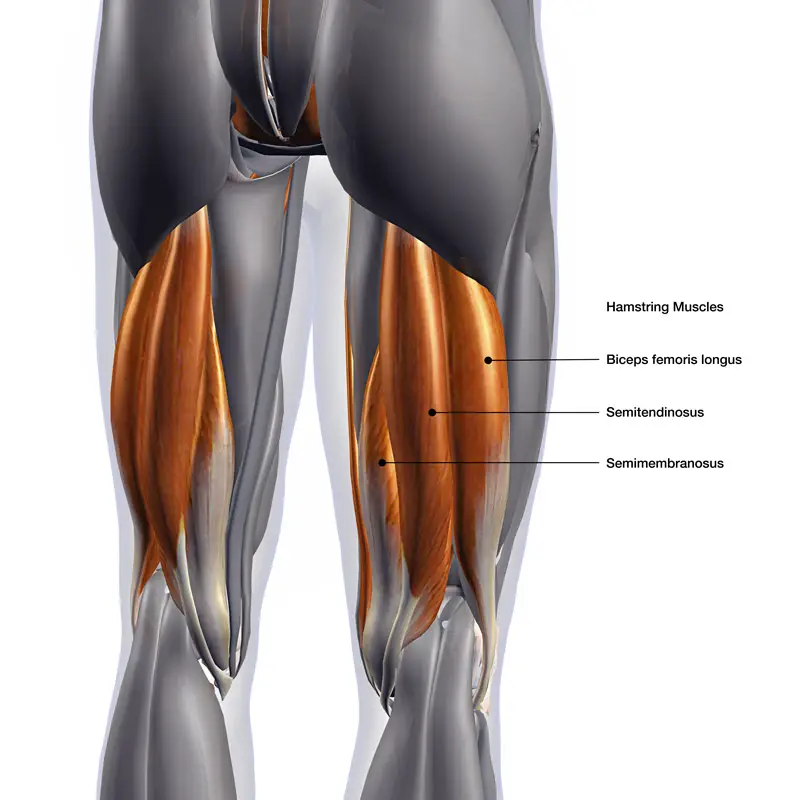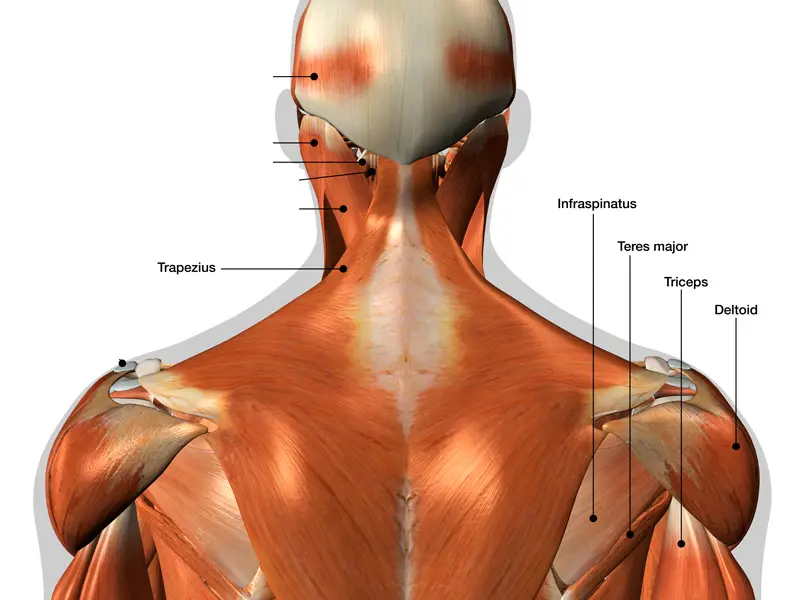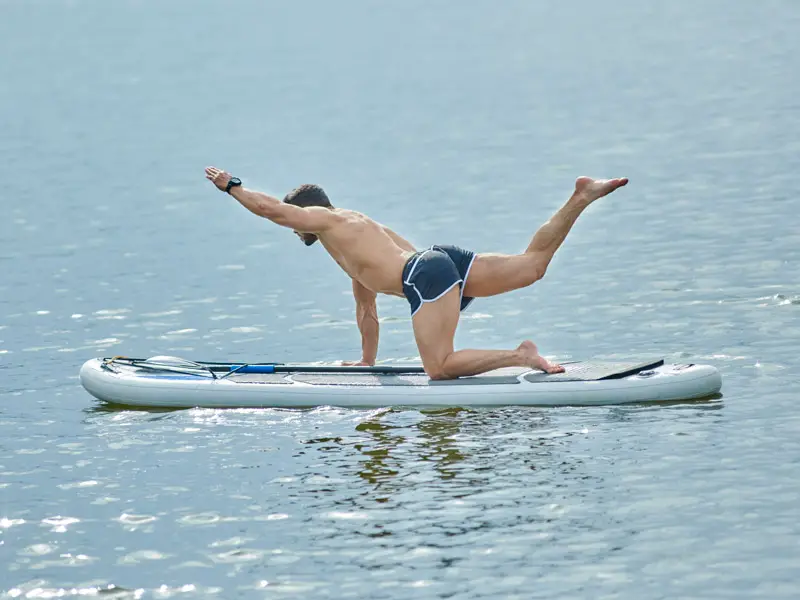Paddle boarding is a great muscle workout! You no doubt are already aware of the overall fitness and health benefits paddle boarding provides. Not only is it a great way to get fresh air and sunshine, spend time with friends, and lower stress levels after a busy week, but you can also actually strengthen specific muscles in your body through paddle boarding!
If you’ve ever asked, “What muscles does paddle boarding work?”, you’ll be glad to know there are multiple muscle groups that can be toned and strengthened while paddling your way around a beautiful body of water on a sunny day! In addition to working your biceps and triceps as your arms reach and pull your paddles through the water, you’re also giving your quadriceps, hamstrings, and heart a great workout, too!
There’s A Lot Happening In Your Hamstrings When You Paddle Board
While you might be familiar with the word “hamstrings” as it refers to the back of your thigh, you might be surprised to learn that there are actually four separate muscles categorized by this term. The hamstrings include the long head biceps femoris and the short head biceps femoris, as well as the semimembranosus and semitendinosus muscles. Your hamstring muscles extend between your hip and your knee.

When you bend your knee, you’re actually using your hamstring muscles to do it. Use of your hamstrings is also directly related to hip flexion, which is the process of movement that occurs to move your leg behind your body. While seasoned paddle boarders make it look easy to jump on a board and transition into a standing position, beginners understand how challenging this can be. If you’ve ever paddle boarded on the ocean or other moving water, you probably know that you use your hamstring muscles to keep from toppling over, as well!
The Hamstring Isn’t The Only Muscle In Your Legs Used When Paddle Boarding
You also use your quadriceps, a group of four muscles at the front of your thigh which are some of the strongest in the body. The four muscles that make up the quadriceps are; the Vastus Lateralis, Vastus Medialis, Vastus Intermedius, and the Rectus Femoris.
The muscles of the quadriceps are critical in most leg movements, allowing you to do everyday things such as walk, run or straighten your leg, and hold your knee cap in place. When the hamstrings contract your legs bend, and the quadreceps work in the opposite direction to streighten the legs.
When you are in a good paddle boarding stance, with knees slightly bent, both your hamstrings and quadriceps are engaged to hold that position. Having these large muscles constantly working is one of the things that makes paddle boarding such a fantastic exercise.
Paddling Requires A Lot Of Arm Movement
The human body is an amazing collection of bones, nerves, muscles, and organs that collectively work in complex systems that allow you to move and function. When you want to tone and strengthen your arms, paddle boarding is a great way to work out. Moving the paddle in order to propel yourself forward on the water, navigate turns or move in reverse means you are using your rotator cuff, as well as your bicep and tricep muscles.
Your rotator cuff is a bundle of tendons. This bundle includes four muscles that help to hold your upper arm in place where it connects to your shoulder. The rotator cuff is comprised of the supraspinatus, infraspinatus, subscapularis and the teres minor muscles. These muscles keep your upper arm bone (humerus) from dislocating when you extend your arm. Your rotator cuff gets a great workout every time you go paddle boarding.
Changing speed on your paddle board can work your bicep and tricep muscles in various ways. The faster you go, the more reps you get in, whereas a slower pace allows you to fully extend and reach with every stroke.

You Are Also Using Muscles In Your Back When You Paddle
As you paddle your way through the water, muscles in your back are helping you to stay standing up straight, and allow the propulsion from your paddle stroke to be transferred to the board beneath your feet. In your back you have the rhombus muscles, the Rhombus Major and Minor that connect your spine with your shoulder blades. You also have your trapezius muscles that are responsible for shrugging and pulling your shoulders back.
Strengthening your back muscles with paddle boarding can help to improve your posture in the long term, which can be especially important if you work in a desk or driving job.
Paddle Boarding Can Help You Sculpt Some Killer Abs
As its name implies, your “core” muscles are the central foundation of overall body movement. Paddle boarding strengthens your core muscles. When you’re doing a core workout, you’re using multiple groups of core muscles, namely your lower back muscles, adductors, gluteus muscles, your transverse abdominis, and pelvic floor muscles.
Is paddle boarding good for you? It is because it helps tone and strengthens your core muscles, which is the key to overall strength, agility, and physical fitness. In short, you can’t achieve maximum physical condition if you have weak core muscles. If you participate in stand-up paddling on a regular basis, you’ll learn to coordinate and use these muscles to gain control over your board and get in great shape at the same time!
Don’t want to get killed getting killer abs? make sure you know the dangers of paddle boarding, check out Is Paddle Boarding Dangerous.
Use Your Paddle Board As A Floor To Exercise
The answer to “What muscles does paddle boarding work?” can really be: all of them, especially if you use your paddle board as a workout platform. In addition to stand-up paddling, there are many other ways to exercise on your paddle board. If you want to increase the challenge of strengthening and toning muscles on a paddle board, you can try to balance on your board while doing push-ups, lunges or yoga stretches. You can also lie in a supine position to do several sets of leg lifts while dipping your hands in the water and basking in the sun!

Use Paddle Boarding For Cardio Training
Don’t forget that your heart is a muscle! Studies show that a sedentary lifestyle can have disastrous effects on the heart. Those who ask, “Is paddle boarding good for you?” will be glad to know that it’s a fantastic way to give the heart (and lungs) a workout. When you use your gluteus muscles, pelvic floor muscles, adductors, hamstrings, quadriceps, as well as biceps and triceps in a synchronized motion to start moving through the water, your heart rate begins to increase. You can get a cardiovascular workout in while strength training!
You’ll Be Using Your Muscles More Than You Realize On A Paddle Board
If you’re stand-up paddling on a moving body of water, it will take a lot of effort and body control to maintain your balance. The way you have to firmly plant yourself on the board, with toes gripping its surface, quadriceps bent in a semi or full squat position and arms extending forward and back to draw the paddle through the water provides a whole body workout. You can increase your level of challenge by competing against friends in some friendly water races or timing yourself from start to finish over a specific distance. As you increase your skill, you can travel further distances for time!
How Many Calories Does Paddle Boarding Burn?
So we have established that paddle boarding uses a lot of different muscle groups, including some of the largest in the body. That must mean that a lot of calories are used paddle boarding, right?
Absolutely! Paddle boarding burns a ton of calories. A study done by SUP World Magazine estimated that just a casual recreational paddle burns 305 – 430 calories an hour, which is about twice what you would burn walking!
But hang on, it gets better. SUP Touring is estimated to burn 615 – 708 calories per hour, SUP Surfing 623 – 735, and SUP Racing an incredible 713 – 1125 calories per hour!
A Round-Up: What Muscles Does Paddle Boarding Work
Paddle boarding truly is a comprehensive full body workout, using muscles in your legs, arms, shoulders, back, and core.
- Legs: Hamstrings (biceps femoris, semimembranosus, and semitendinosus) and Quadriceps (vastus lateralis, vastus medialis, vastus intermedius, and the rectus femoris)
- Arms: Biceps and Triceps
- Shoulders: The rotator cuff (supraspinatus, infraspinatus, subscapularis and the teres minor)
- Back: The Rhombus (rhombus major and rhombus minor) and Trapezius muscles
- Core: Lower back muscles, Abs (Rectus abdominis, transverse abdominis, internal/external obliques) Adductors, Glutes, and Pelvic Floor Muscles
- The Heart
Paddle Boarding Is A Fun Way To Exercise
If it’s your first time on a paddle board, you might be surprised at how sore you feel the next day! The more often you go and the more you learn to perfect your movements and position on the board, the less sore you might be afterward but the happier you’ll be as you begin to notice positive fitness results. There are more than 650 muscles in your body. Each of them has a vital function, from enabling mobility to pumping your heart or helping you digest food. Paddle boarding is a fun activity that provides a great workout for all the major muscle groups in your body!
Sold on paddle boarding and want to add it into your exercise regimen? Check out How Hard Is Stand Up Paddle Boarding.
